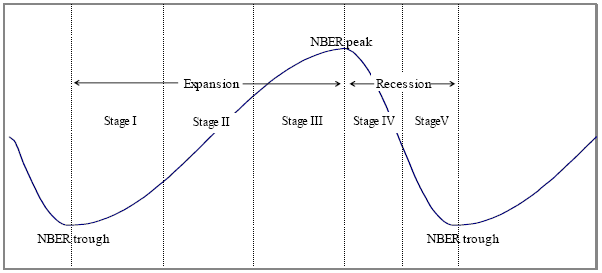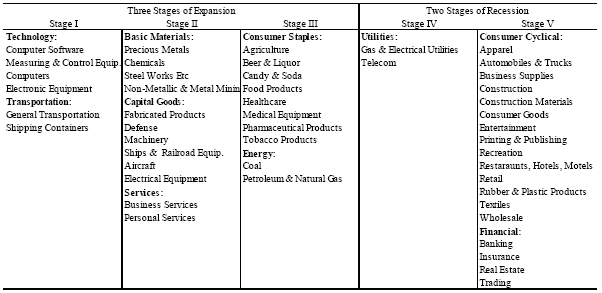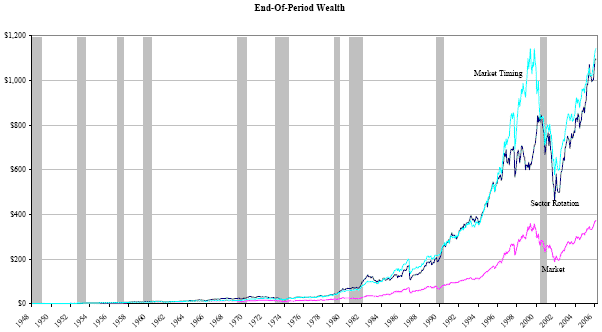
What stock market sector have you been in lately? The sectors that are beating the market or the ones that are trailing behind? Sector rotation is a proven investing strategy that can make a significant difference in the performance of your portfolio. However, it is imperative to be aligned with the overall economic cycle before focusing on which sectors should receive your capital. In this article, we examine two recent studies on sector rotation that help illuminate the opportunities and the problems for investors. Moreover, these studies highlight the importance following the overall economic cycle before picking the best sectors to invest.
In a paper published in July 2007 titled
"Sector Rotation over
Business-Cycles", Jeffrey Stangl, Ben Jacobson and Nuttawat Visaltanachoti
tested the sector rotation theory described by Stan Stovell’s book
Standard & Poor's Guide to Sector Investing 1995![]() .
The following figure, taken from the paper, is an idealized NBER-style business
cycle divided into five stages as done in other studies. Economic expansions
span trough to peak in Stages I-III; recessions, peak to trough in Stages IV-V.
As indicated, expansions typically last longer than recessions.
.
The following figure, taken from the paper, is an idealized NBER-style business
cycle divided into five stages as done in other studies. Economic expansions
span trough to peak in Stages I-III; recessions, peak to trough in Stages IV-V.
As indicated, expansions typically last longer than recessions.

The following table is based on
Standard & Poor's Guide to Sector Investing 1995![]() describes what sectors
should perform best in each stage of the business cycle.
describes what sectors
should perform best in each stage of the business cycle.

In the same article "Sector Rotation over Business-Cycles" Stangl, et al, compare the performance of a Market Strategy that follows the stock market for the entire period of the study compared to perfect hindsight strategies that used Sector Rotation and Market Timing.
The chart below shows cumulative wealth from an initial investment of one dollar over the period 1948-2006 for three different strategies. The Market strategy maintains a portfolio that mirrors the stock market for the entire period. The Sector Rotation strategy uses perfect hindsight to buy and sell stocks in sector portfolios in equal weights during the business cycle stage according to the Sector Rotation model. The Market Timing strategy holds the market portfolio during business cycle Stages I, II, III and V and cash during Stage IV. The results of these three strategies show the simpler Market Timing strategy has greater potential than the Sector Rotation strategy. Moreover, it also shows that timing strategies would beat buy-and-hold for an investor/trader who can accurately anticipate business cycle phases.

NBER tracks business cycle turning points (peaks and troughs), not the five phases of the business cycle as described above. In addition the NBER can take as long as two years after a turning point to designate its date. They also note each business cycle can be very different from another. This means investors cannot depend on the NBER to time there sector rotation trades.
This study shows that sector rotation as defined by the Stovell can generate returns that beat the market by investing in the Stovell sectors aligned with the NBER economic cycles. However, perfect hindsight is not the real world and investors are not likely to replicate the returns of the study. It is a matter of timing the entry and exit from the position based on where one is in the economic cycle. Unfortunately, economic cycles do not follow well-defined cycles, making the timing strategy a difficult one.
When using a sector rotation strategy as defined by Stovell and the NBER, an investor must be able to anticipate when the market would transition from one stage to another if they hope to beat the market.
In another recently completed study titled Sector Rotation and Monetary Conditions” (PDF) show that U.S. Federal Reserve interest rate policy changes are associated with strong patterns in equity returns. The article, authored by Robert Johnson, C. Mitchell Conover, Gerald R. Jensen, and Jeffrey M. Mercer, published in the Journal of Investing indicates that a sector rotation strategy based on the Federal Reserve rate changes could substantially improve a portfolios performance over the past 33 years. According to the study, investors outperform the market using a more aggressive strategy when the discount rate is decreasing and a more defensive strategy when the Fed is raising rates.
The key empirical findings reported in the study include the following:
Consistent with expectations, these authors found that the actual returns varied across sectors. Cyclical stocks exhibit far more sensitivity to changes in monetary conditions. Shifting the make up of the portfolio when a change in the direction of Fed discount rates changes, generates statistically better returns. Specifically, performance is enhanced by shifting into cyclical stocks following rate decreases (a signal of more expansive monetary policy), while the appropriate response to a signal of a more restrictive Fed policy is a shift to defensive stocks. The cyclical sectors include consumer discretionary, energy, financial, healthcare, industrials, materials, and technology. The non-cyclical sectors include consumer staples and utilities. Of course, cash also works well when the market is heading down.
Using sector rotation to time you entry and exit from a sector can work if one is able to accurately identify the transition from one cycle to the other. However, knowing where one is within the economic cycle is a more difficult problem. Fortunately, there are strategies that investors can employ to align their portfolios with the performance of each sector as we transition from one phase to another.
Investors using sector rotation investing strategies can achieve superior results. As shown in these studies it is important to have a strategic perspective of the economy before delving into the phases and a sector rotation investing strategy.
Our Premium Members receive weekly updates on important and relevant trends for the stock market, industry sectors and individual stocks and ETFs. By following the trends, we have beat the market every year since our inception. You should give our four-week free trial to the Premium Membership a try. There is no risk, nor any obligation. If you have any questions regarding membership, please send an email to [email protected] and we will get right back to you. Your complete satisfaction is of utmost importance to us.